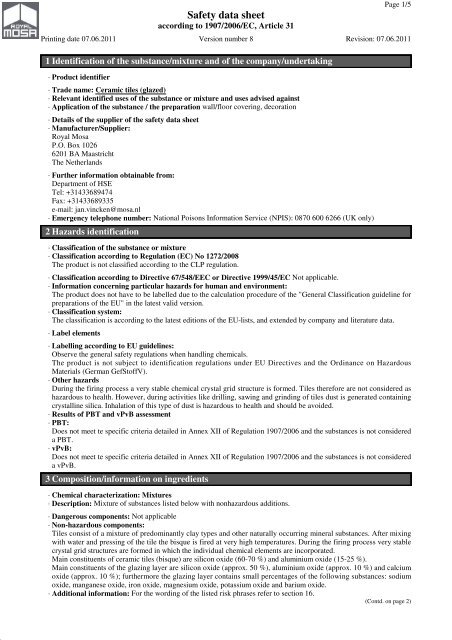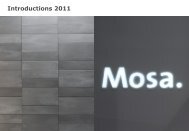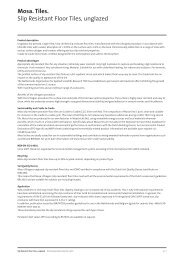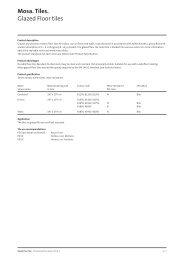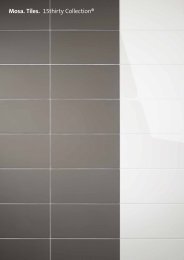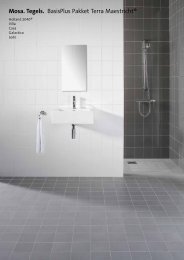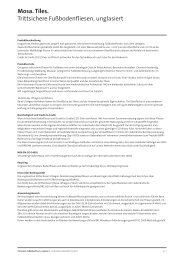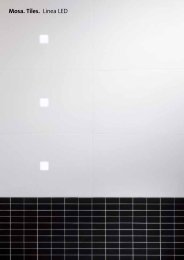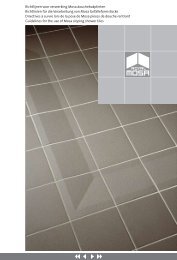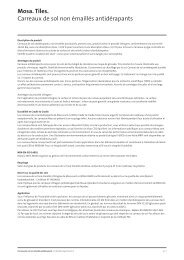Download the Safety Data Sheet for glazed wall tiles - Mosa
Download the Safety Data Sheet for glazed wall tiles - Mosa
Download the Safety Data Sheet for glazed wall tiles - Mosa
- No tags were found...
Create successful ePaper yourself
Turn your PDF publications into a flip-book with our unique Google optimized e-Paper software.
DR<strong>Safety</strong> data sheetaccording to 1907/2006/EC, Article 31Page 1/5Printing date 07.06.2011 Version number 8Revision: 07.06.20111 Identification of <strong>the</strong> substance/mixture and of <strong>the</strong> company/undertaking· Product identifier· Trade name: Ceramic <strong>tiles</strong> (<strong>glazed</strong>)· Relevant identified uses of <strong>the</strong> substance or mixture and uses advised against· Application of <strong>the</strong> substance / <strong>the</strong> preparation <strong>wall</strong>/floor covering, decoration· Details of <strong>the</strong> supplier of <strong>the</strong> safety data sheet· Manufacturer/Supplier:Royal <strong>Mosa</strong>P.O. Box 10266201 BA MaastrichtThe Ne<strong>the</strong>rlands· Fur<strong>the</strong>r in<strong>for</strong>mation obtainable from:Department of HSETel: +31433689474Fax: +31433689335e-mail: jan.vincken@mosa.nl· Emergency telephone number: National Poisons In<strong>for</strong>mation Service (NPIS): 0870 600 6266 (UK only)2 Hazards identification· Classification of <strong>the</strong> substance or mixture· Classification according to Regulation (EC) No 1272/2008The product is not classified according to <strong>the</strong> CLP regulation.· Classification according to Directive 67/548/EEC or Directive 1999/45/EC Not applicable.· In<strong>for</strong>mation concerning particular hazards <strong>for</strong> human and environment:The product does not have to be labelled due to <strong>the</strong> calculation procedure of <strong>the</strong> "General Classification guideline <strong>for</strong>preparations of <strong>the</strong> EU" in <strong>the</strong> latest valid version.· Classification system:The classification is according to <strong>the</strong> latest editions of <strong>the</strong> EU-lists, and extended by company and literature data.· Label elements· Labelling according to EU guidelines:Observe <strong>the</strong> general safety regulations when handling chemicals.The product is not subject to identification regulations under EU Directives and <strong>the</strong> Ordinance on HazardousMaterials (German GefStoffV).· O<strong>the</strong>r hazardsDuring <strong>the</strong> firing process a very stable chemical crystal grid structure is <strong>for</strong>med. Tiles <strong>the</strong>re<strong>for</strong>e are not considered ashazardous to health. However, during activities like drilling, sawing and grinding of <strong>tiles</strong> dust is generated containingcrystalline silica. Inhalation of this type of dust is hazardous to health and should be avoided.· Results of PBT and vPvB assessment· PBT:Does not meet te specific criteria detailed in Annex XII of Regulation 1907/2006 and <strong>the</strong> substances is not considereda PBT.· vPvB:Does not meet te specific criteria detailed in Annex XII of Regulation 1907/2006 and <strong>the</strong> substances is not considereda vPvB.3 Composition/in<strong>for</strong>mation on ingredients· Chemical characterization: Mixtures· Description: Mixture of substances listed below with nonhazardous additions.· Dangerous components: Not applicable· Non-hazardous components:Tiles consist of a mixture of predominantly clay types and o<strong>the</strong>r naturally occurring mineral substances. After mixingwith water and pressing of <strong>the</strong> tile <strong>the</strong> bisque is fired at very high temperatures. During <strong>the</strong> firing process very stablecrystal grid structures are <strong>for</strong>med in which <strong>the</strong> individual chemical elements are incorporated.Main constituents of ceramic <strong>tiles</strong> (bisque) are silicon oxide (60-70 %) and aluminium oxide (15-25 %).Main constituents of <strong>the</strong> glazing layer are silicon oxide (approx. 50 %), aluminium oxide (approx. 10 %) and calciumoxide (approx. 10 %); fur<strong>the</strong>rmore <strong>the</strong> glazing layer contains small percentages of <strong>the</strong> following substances: sodiumoxide, manganese oxide, iron oxide, magnesium oxide, potassium oxide and barium oxide.· Additional in<strong>for</strong>mation: For <strong>the</strong> wording of <strong>the</strong> listed risk phrases refer to section 16.(Contd. on page 2)
DR<strong>Safety</strong> data sheetaccording to 1907/2006/EC, Article 31Page 2/5Printing date 07.06.2011 Version number 8Revision: 07.06.2011Trade name: Ceramic <strong>tiles</strong> (<strong>glazed</strong>)4 First aid measures(Contd. of page 1)· Description of first aid measures· General in<strong>for</strong>mation:This section only applies to <strong>the</strong> handling of <strong>tiles</strong> (drilling, cutting, sawing, grinding, removal, etc.)· After inhalation: Supply fresh air; consult doctor in case of complaints.· After skin contact: Generally <strong>the</strong> product does not irritate <strong>the</strong> skin.· After eye contact: Rinse opened eye <strong>for</strong> several minutes under running water.· After s<strong>wall</strong>owing: If symptoms persist consult doctor.· In<strong>for</strong>mation <strong>for</strong> doctor:· Most important symptoms and effects, both acute and delayed See Chapter 11.· Indication of any immediate medical attention and special treatment needed Provide general first aid.5 Firefighting measures· Extinguishing media· Suitable extinguishing agents: Not applicable.· Special hazards arising from <strong>the</strong> substance or mixture Not applicable.· Advice <strong>for</strong> firefighters· Protective equipment: No special measures required.6 Accidental release measures· Personal precautions, protective equipment and emergency proceduresIn <strong>the</strong> event of generation of large amounts of dust during processing: provide adequate ventilation; wear a respirator(type P3); clean up dust using an industrial vacuum or by damp sweeping· Environmental precautions: No special measures required.· Methods and material <strong>for</strong> containment and cleaning up: Pick up mechanically.· Reference to o<strong>the</strong>r sectionsNo dangerous substances are released.See Section 7 <strong>for</strong> in<strong>for</strong>mation on safe handling.See Section 8 <strong>for</strong> in<strong>for</strong>mation on personal protection equipment.See Section 13 <strong>for</strong> disposal in<strong>for</strong>mation.7 Handling and storage· Handling:· Precautions <strong>for</strong> safe handling No special measures required.· In<strong>for</strong>mation about fire - and explosion protection: No special measures required.· Conditions <strong>for</strong> safe storage, including any incompatibilities· Storage:· Requirements to be met by storerooms and receptacles: No special requirements.· In<strong>for</strong>mation about storage in one common storage facility: Not required.· Fur<strong>the</strong>r in<strong>for</strong>mation about storage conditions: None.· Specific end use(s) No fur<strong>the</strong>r relevant in<strong>for</strong>mation available.8 Exposure controls/personal protection· Additional in<strong>for</strong>mation about design of technical facilities: No fur<strong>the</strong>r data; see item 7.· Control parameters· Ingredients with limit values that require monitoring at <strong>the</strong> workplace:The product does not contain any relevant quantities of materials with critical values that have to be monitored at <strong>the</strong>workplace.· Additional in<strong>for</strong>mation:During occupational processing of <strong>tiles</strong> (drilling, sawing, grinding of <strong>tiles</strong>; removal of old tile layers) large amounts ofdust can be generated. This dust contains silica.Substance: Crystalline silica Occupational exposure limit: 0,075 mg/m3 Remarks: respirable dust; legally bindingOEL.The lists valid during <strong>the</strong> making were used as basis.(Contd. on page 3)
DR<strong>Safety</strong> data sheetaccording to 1907/2006/EC, Article 31Page 3/5Printing date 07.06.2011 Version number 8Revision: 07.06.2011Trade name: Ceramic <strong>tiles</strong> (<strong>glazed</strong>)(Contd. of page 2)· Exposure controls· Personal protective equipment:· Respiratory protection:Always use respiratory protection during sawing or grinding, in combination with local exhaust ventilation. A type P3filtering piece is sufficient.When not applying local exhaust ventilation or wet sawing or grinding methods, a (half or full mask) respirator withmotor/filterunit (type TM3P) should be used. This is also recommended during removal of old <strong>tiles</strong>.· Protection of hands: Wear cotton or lea<strong>the</strong>r working gloves during processing of <strong>tiles</strong>.· Eye protection:Wear safety glasses with side shields or a face shield when sawing or grinding <strong>tiles</strong> or removing old <strong>tiles</strong>. Avoidwearing contact lenses.· Risk management measuresTechnical measures:Bring <strong>tiles</strong> down to size using cutting instead of sawing or grinding methods.During sawing or grinding of <strong>tiles</strong> or removal of old <strong>tiles</strong> use local exhaust ventilation combined with collection ofdust; wet sawing or grinding methods are to be preferred (sawing and grinding equipment with water supply;application of (semi) automatic removal equipment with moistening facility).9 Physical and chemical properties· In<strong>for</strong>mation on basic physical and chemical properties· General In<strong>for</strong>mation· Appearance:Form:SolidColour:Different according to colouring· Odour: Odourless· Odour threshold: Not determined.· pH-value: Not applicable.· Change in conditionMelting point/Melting range:Boiling point/Boiling range:Not applicable.Undetermined.· Flash point: Not applicable.· Flammability (solid, gaseous): Not determined.· Ignition temperature:Decomposition temperature:Not determined.· Self-igniting: Product is not selfigniting.· Danger of explosion: Product does not present an explosion hazard.· Explosion limits:Lower:Upper:Not determined.Not determined.· Vapour pressure: Not applicable.· Density: Not determined.· Relative density Not determined.· Vapour density Not applicable.· Evaporation rate Not applicable.· Solubility in / Miscibility withwater:Insoluble.· Segregation coefficient (n-octanol/water): Not determined.· Viscosity:Dynamic:Not applicable.Kinematic:Not applicable.· O<strong>the</strong>r in<strong>for</strong>mation No fur<strong>the</strong>r relevant in<strong>for</strong>mation available.(Contd. on page 4)
DR<strong>Safety</strong> data sheetaccording to 1907/2006/EC, Article 31Page 4/5Printing date 07.06.2011 Version number 8Revision: 07.06.2011Trade name: Ceramic <strong>tiles</strong> (<strong>glazed</strong>)10 Stability and reactivity(Contd. of page 3)· Reactivity· Chemical stability· Thermal decomposition / conditions to be avoided: No decomposition if used according to specifications.· Possibility of hazardous reactions No dangerous reactions known.· Conditions to avoid No fur<strong>the</strong>r relevant in<strong>for</strong>mation available.· Incompatible materials: Contact with strong acids· Hazardous decomposition products: No dangerous decomposition products known.11 Toxicological in<strong>for</strong>mation· In<strong>for</strong>mation on toxicological effects· Acute toxicity:· Primary irritant effect:· on <strong>the</strong> skin: Skin irritation due to mechanical abrasion.· on <strong>the</strong> eye: Eye irritation due to exposure to high dust concentrations.· Sensitization: No sensitizing effects known.· Subacute to chronic toxicity:Long term inhalatory exposure to crystalline silica above current occupational exposure limits may lead to silicosis(development of fibrotic nodules in lung tissue) and is also associated with a number of o<strong>the</strong>r diseases (bronchitis,emphysema, etc.). Smoking may increase <strong>the</strong> risk on adverse effects.· Additional toxicological in<strong>for</strong>mation:The product is not subject to classification according to <strong>the</strong> calculation method of <strong>the</strong> General EU ClassificationGuidelines <strong>for</strong> Preparations as issued in <strong>the</strong> latest version.When used and handled according to specifications, <strong>the</strong> product does not have any harmful effects to our experienceand <strong>the</strong> in<strong>for</strong>mation provided to us.· Acute effects (acute toxicity, irritation and corrosivity)Although cases of development of acute silicosis due to short time exposure to very high concentrations of crystallinesilica are described in literature, occurrence of this type of disease is very rare.· CMR effects (carcinogenity, mutagenicity and toxicity <strong>for</strong> reproduction)Crystalline silica is classified as a human carcinogen (Group I) by <strong>the</strong> IARC (International Agency <strong>for</strong> Research onCancer).12 Ecological in<strong>for</strong>mation· Toxicity· Acquatic toxicity: Product is not soluble in water and not toxic.· Persistence and degradability This product is according to previous experiences inert and non-degradable.· Behaviour in environmental systems:· Bioaccumulative potential Does not accumulate in organisms· Mobility in soil No fur<strong>the</strong>r relevant in<strong>for</strong>mation available.· Additional ecological in<strong>for</strong>mation:· General notes: Generally not hazardous <strong>for</strong> water· Results of PBT and vPvB assessment· PBT:Does not meet te specific criteria detailed in Annex XII of Regulation 1907/2006 and <strong>the</strong> substances is not considereda PBT.· vPvB:Does not meet te specific criteria detailed in Annex XII of Regulation 1907/2006 and <strong>the</strong> substances is not considereda vPvB.· O<strong>the</strong>r adverse effects No fur<strong>the</strong>r relevant in<strong>for</strong>mation available.13 Disposal considerations· Waste treatment methods· Recommendation Smaller quantities can be disposed of with household waste.· Uncleaned packaging:· Recommendation: Disposal must be made according to official regulations.(Contd. on page 5)
DR<strong>Safety</strong> data sheetaccording to 1907/2006/EC, Article 31Page 5/5Printing date 07.06.2011 Version number 8Revision: 07.06.2011Trade name: Ceramic <strong>tiles</strong> (<strong>glazed</strong>)14 Transport in<strong>for</strong>mation(Contd. of page 4)· Land transport ADR/RID (cross-border)· ADR/RID class: -· Maritime transport IMDG:· IMDG Class: -· Marine pollutant: No· Air transport ICAO-TI and IATA-DGR:· ICAO/IATA Class: -· UN "Model Regulation": -· Special precautions <strong>for</strong> user Not applicable.· Transport in bulk according to Annex II of MARPOL73/78 and <strong>the</strong> IBC Code Not applicable.15 Regulatory in<strong>for</strong>mation· Chemical safety assessment: A Chemical <strong>Safety</strong> Assessment has not been carried out.16 O<strong>the</strong>r in<strong>for</strong>mationThis in<strong>for</strong>mation is based on our present knowledge. However, this shall not constitute a guarantee <strong>for</strong> any specificproduct features and shall not establish a legally valid contractual relationship.When installing or processing <strong>tiles</strong> please take note of <strong>the</strong> following additional safety measures:• Wear adequate working clo<strong>the</strong>s• Wear knee protection• Wear safety shoes• Use appropriate lifting and transporting equipmentThe in<strong>for</strong>mation and data in this <strong>Safety</strong> <strong>Data</strong> <strong>Sheet</strong> are based on current scientific and technical state of <strong>the</strong> art and arebelieved to be accurate at <strong>the</strong> printing date.The in<strong>for</strong>mation refers solely to <strong>the</strong> product indicated and constitutes no guarantee of particular quality.It is <strong>the</strong> duty of <strong>the</strong> user to ensure that this in<strong>for</strong>mation is appropriate and complete with respect to <strong>the</strong> specific useintended.This MSDS cancels and replaces any preceding release.· Abbreviations and acronyms:NOEC: No Observed Effect ConcentrationIC50: Inhibition Concentration, 50 percentADR: Accord européen sur le transport des marchandises dangereuses par Route (European Agreement concerning <strong>the</strong> International Carriage ofDangerous Goods by Road)RID: Règlement international concernant le transport des marchandises dangereuses par chemin de fer (Regulations Concerning <strong>the</strong> InternationalTransport of Dangerous Goods by Rail)IMDG: International Maritime Code <strong>for</strong> Dangerous GoodsIATA: International Air Transport AssociationIATA-DGR: Dangerous Goods Regulations by <strong>the</strong> "International Air Transport Association" (IATA)ICAO: International Civil Aviation OrganizationICAO-TI: Technical Instructions by <strong>the</strong> "International Civil Aviation Organization" (ICAO)GHS: Globally Harmonized System of Classification and Labelling of Chemicals


